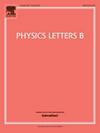基于天基引力波探测网络的随机引力波背景探测
IF 4.5
2区 物理与天体物理
Q1 ASTRONOMY & ASTROPHYSICS
引用次数: 0
摘要
随机引力波背景(SGWB)是未来毫赫空间引力波天文台的主要探测目标之一,如激光干涉仪空间天线(LISA)、天琴和太极。对于单个类lisa检测器,开发了一种零通道方法,通过将来自a和E通道的数据与仅噪声的T通道集成来识别SGWB。然而,如果其中一个激光干涉仪臂失效,噪声监测通道将不可用。通过结合这些探测器,将有可能建立探测器网络,通过相互关联分析来搜索SGWB。在这项工作中,我们开发了一种基于延时干涉(TDI)迈克尔逊型信道的贝叶斯数据分析方法。然后,我们研究了天津lisa探测器网络对各种各向同性SGWB的可探测性。假设三个月的观测,对于幂律模型、平坦模型和单峰模型,天琴- lisa探测器网络可以自信地探测到能量密度分别低至ΩPL=6.0×10−13、ΩFlat=2.0×10−12和ΩSP=1.2×10−12的SGWB。本文章由计算机程序翻译,如有差异,请以英文原文为准。
Detection of the stochastic gravitational wave background with the space-based gravitational-wave detector network
The stochastic gravitational wave background (SGWB) is one of the main detection targets for future millihertz space-based gravitational-wave observatories such as the laser interferometer space antenna (LISA), TianQin, and Taiji. For a single LISA-like detector, a null-channel method was developed to identify the SGWB by integrating data from the A and E channels with a noise-only T channel. However, the noise monitoring channel will not be available if one of the laser interferometer arms fails. By combining these detectors, it will be possible to build detector networks to search for SGWB via cross-correlation analysis. In this work, we developed a Bayesian data analysis method based on time delay interferometry (TDI) Michelson-type channel. We then investigate the detectability of the TianQin-LISA detector network for various isotropic SGWB. Assuming a three-month observation, the TianQin-LISA detector network could be able to confidently detect SGWB with energy density as low as , and for power-law, flat and single-peak models, respectively.
求助全文
通过发布文献求助,成功后即可免费获取论文全文。
去求助
来源期刊

Physics Letters B
物理-物理:综合
CiteScore
9.10
自引率
6.80%
发文量
647
审稿时长
3 months
期刊介绍:
Physics Letters B ensures the rapid publication of important new results in particle physics, nuclear physics and cosmology. Specialized editors are responsible for contributions in experimental nuclear physics, theoretical nuclear physics, experimental high-energy physics, theoretical high-energy physics, and astrophysics.
 求助内容:
求助内容: 应助结果提醒方式:
应助结果提醒方式:


